A comprehensive macaron troubleshooting guide with photos, possible causes and how to avoid the most common macaron issues!
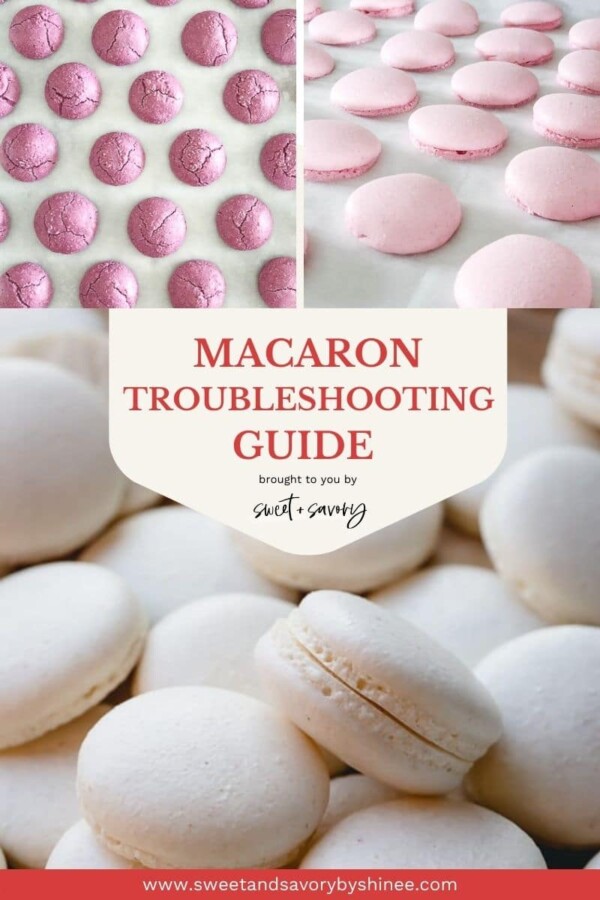
Table of Contents
Since 2012, I’ve made thousands of macarons in my home kitchen with many trials and errors, as well as picture-perfect macarons! And yes, I’ve had pretty much every problem imaginable!!
In the process, I’ve gained lots of tips and tricks to solve those frustrating issues and, most importantly, how to avoid them in the first place.
Remember, sometimes, macarons fail for no apparent reason and leave us scratching our heads.
But I encourage you to never give up on macarons. The joy of watching your macarons grow those ruffled feet and pulling out perfectly round macarons with shiny smooth tops is simply priceless.
I swear, every single time, when I see my macarons through the oven door puffing up and baking perfectly, I can’t help but do a little happy dance in my kitchen! Pure joy, I’m telling ya!
What’s a perfect macaron?
Perfect macaron is very subjective. To me, a perfect macaron has the following characteristics:
- Smooth shells
- Ruffles feet
- Full inside

Macaron Troubleshooting Video
Visual Macaron Troubleshooting Guide
Ok, let’s discuss each of the most common macaron issues, their causes and how to fix or prevent them!

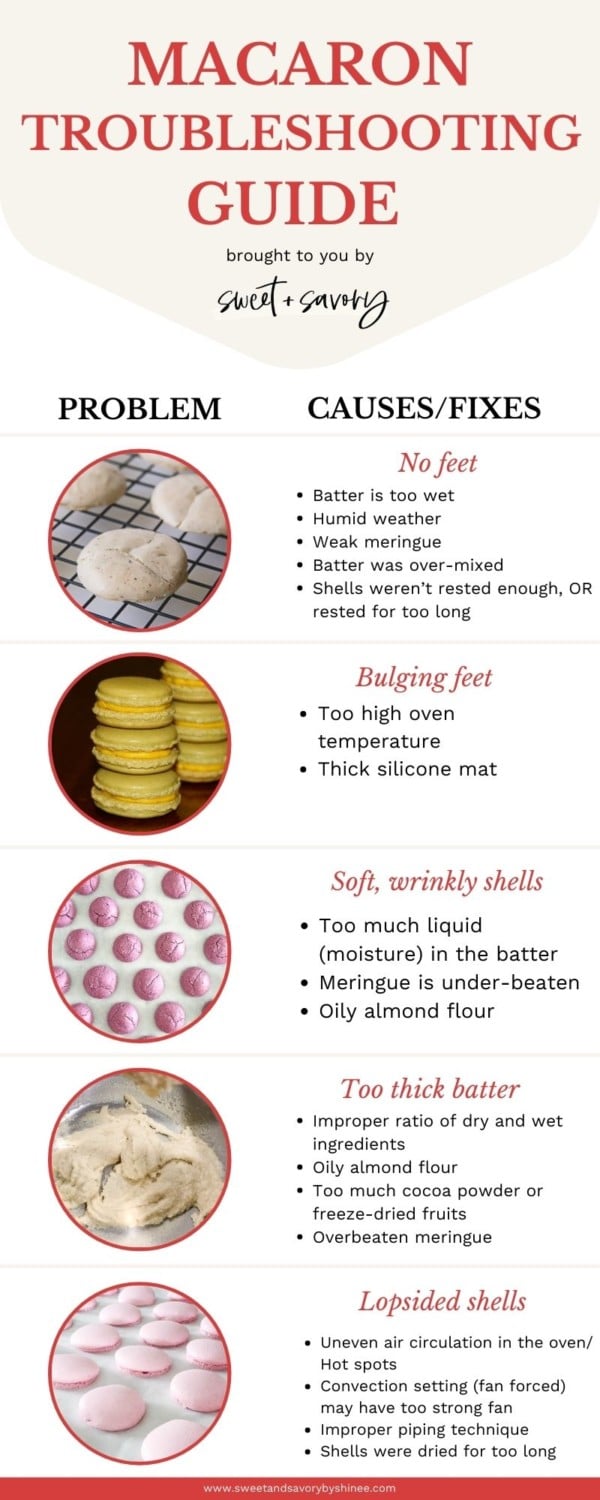
Pin this now to find it later
Pin ItUneven, grainy macarons with nipples
Possible causes:
- Too coarse almond flour
- Dry ingredients weren’t sifted
- Batter was under-mixed
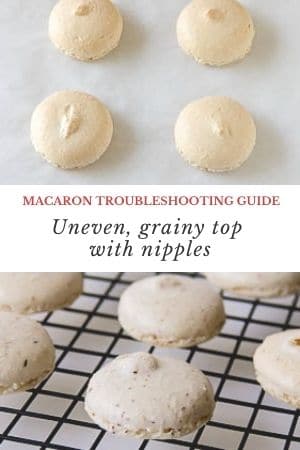
how to fix grainy shells with nipples:
- Make sure to use fine ground almond flour.
- Don’t skip sifting the dry ingredients! Toss large almond pieces left in the sifter. You shouldn’t have more than 1/2 tablespoon of almond bits.
- Under-mixed batter also causes grainy shells with nipples. When mixed right, the nipples should melt back into the batter after tapping the piped shells on the counter.
don’t do this!
Never use wet fingers to push the nipples down. Instead, use a toothpick to encourage the batter even out.
Cracked shells
Possible causes:
- Too much air in the shell
- High humidity
- Shells weren’t rested
- Weak meringue
- High oven temperature, or hot spots in the oven
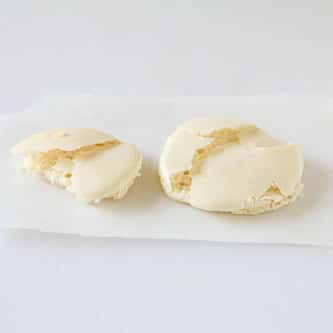
HOW TO FIX cracked macarons:
- Be sure to tap the baking sheet right after piping macaron shells. And use a toothpick to pop large air pockets visible on the surface.
- When it’s too humid, the shells don’t develop good skin, which leads to the next point.
- When the shells haven’t rested long enough to develop skin on top, steam releases from anywhere cause macarons to crack on top.
- Take your time to make nice and sturdy meringue, especially when you’re making French meringue. Watch my video on French Meringue 101 to learn all the tips to make the most stable French meringue.
- Too hot oven can also cause cracks in macaron shells. Make sure to get an oven thermometer to double check the temperature inside the oven without relying on what oven says.
Erupted shells
Possible cause:
- Touched the shells with wet finger to push down a pointy nipple
How to prevent erupted volcano macarons:
Never touch your unbaked macaron shells with wet fingers to push down pointy end. Instead tap the baking sheet well. And if the pointy end doesn’t melt into the batter, you can either baking them as is, or scrape the batter back into a bowl and mix for a little more until the batter is at correct consistency.
Too crispy interior
Possible cause:
- Shells were over-baked

How to fix too crispy shells:
If you over-baked your macaron shells and now they’re super crispy throughout, don’t fret! 2 easy fixes:
- Use wet fillings, like jams, caramel sauce, or lemon curd in the center.
- Simply brush on milk on the bottom of the shells before piping a filling of choice.
Tip
Mature filled macarons for 24 hours. The shells will absorb the moisture from filling and macarons should soften nicely.
Flat shells, spread out too much
Possible cause:
- Batter was over-mixed
Over-mixed batter is too loose and the shells don’t hold its shape well, instead it spreads out too much.

How to prevent flat, spread out macarons:
Once macaron batter is over-mixed and it’s too runny, there’s no way to salvage it. So it’s important to prevent this from happening.
Make sure to check the batter often for the correct consistency. It should slowly run off the spatula into a ribbon, and the edges should melt back into the batter within about 10 seconds.
Hollow shells
Possible cause:
- Issue with meringue
- Over-mixed batter
- Improper piping technique
- Too high oven temperature
- Under-baked macaron shells

How to fix hollow macaron shells:
Hollow macarons are so common, and I personally battled with this issue for a long time. Now, I consistently get full, meaty macarons straight from the oven.
Since it’s a complex issue, I dedicated a separate post on how to fix hollow macarons.
No feet
Potential causes:
- Batter is too wet
- Humid weather
- Weak meringue
- Batter was over-mixed
- Shells weren’t rested before baking
- Shells were rested for too long, weakening the meringue structure
- Too low oven temperature

How to prevent no feet macarons:
- When the batter is too wet, macarons don’t develop those ruffled feet. The most common causes for wet batter: excess liquids, like extracts, lemon/lime juice, liquid food coloring, too much gel food coloring, etc.
- In some cases, especially in humid climates, aging egg whites might be beneficial. During aging, egg whites loose some of its moisture.
- When the meringue isn’t whipped to stiff peaks, it doesn’t have strong enough structure to lift macarons. Watch my French Meringue 101 video for visual cues for proper meringue.
- When macaron batter is over-mixed, there’s not much air bubbles left to give the shells lift during baking. Therefore, they come out flat without feet.
- Also, if macarons weren’t rested to form a skin before baking, it could cause no feet macarons. And if the shells were rested for too long, it can also negatively affect the batter, because meringue loses its stability when sat for too long. Keep checking the shells every 15 minutes and put them in the oven as soon as they don’t stick to your fingers.
- If the oven is not hot enough, macarons won’t rise as air bubbles in the meringue need heat to expand to lift the shells, creating that pretty feet at the base.
Tip
Make sure to get an oven thermometer to double check the temperature inside the oven without relying on what oven says.
Bulging feet
Potential causes:
- Too high oven temperature
- Silicone mat

how to prevent bulging feet:
Some may find it ugly when the ruffled feet extends out of the macaron shells. I’m not a huge fan, but it’s not the worst!
- This happens when the oven is a bit too hot, causing the macarons to rise too high and then collapse slightly, making the feet bulge out.
- And another reason is silicone mat might be the culprit. I certainly happens to me with thick silicone mats, but I know some people have gorgeous macarons with silicone mats.
Soft, wrinkly shells
Possible causes:
- Too much liquid (moisture) in the batter
- Meringue is under-beaten
- Oily almond flour

How to prevent soft, wrinkly shells:
Excess moisture and/or fat is the #1 cause for soft, wrinkly shells. And there’re number of culprits for excess moisture/fat in the batter:
- Adding liquid extracts, juices or liquid food coloring
- Adding cocoa powder, freeze-dried fruits, etc.
- Under-mixed meringue also contains too much moisture
- Oily almond flour, or almond flour that has been opened for too long
Cocoa powder contains fat which could potentially cause soft, brownie-like macaron shells. And freeze-dried fruits absorb moisture from the air fast and could cause soft, wrinkly shells as well.
Tip
Store opened almond flour in an airtight container in a cool place.
Too Thick batter
Typically, when you add dry ingredients into meringue, it starts out pretty thick and that’s totally normal. As you fold the batter, it thins out and gets runnier.
In rare occasions, the batter never loosens and it stays thick.
Possible causes:
- Improper ratio of dry and wet ingredients
- Oily almond flour
- Too much cocoa powder or freeze-dried fruits
- Overbeaten meringue
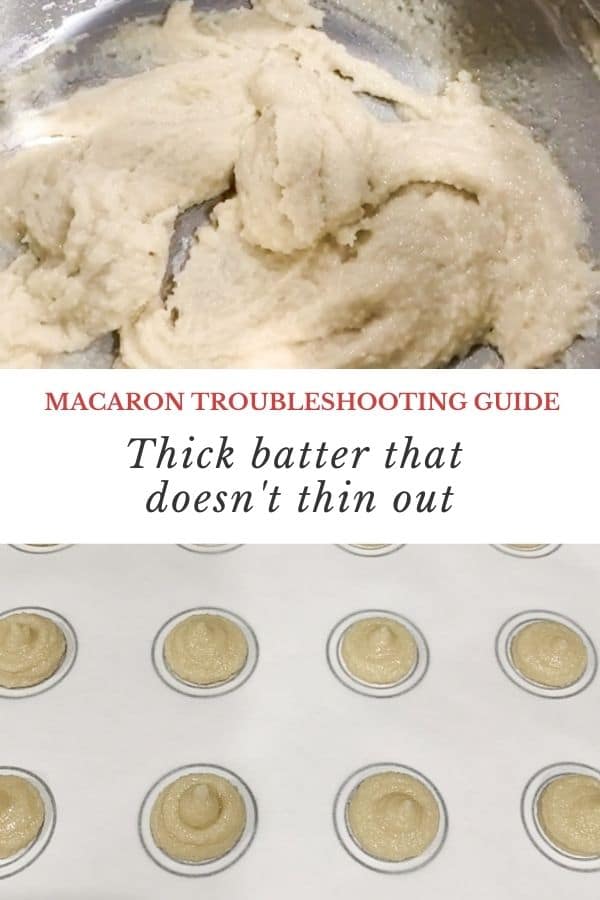
how to fix and prevent thick batter issue:
- Be sure to weigh the ingredients carefully. I strongly recommend weighing all the ingredients, including egg whites, with a kitchen scale.
- Oily almond flour could cause thick batter. Make sure to use fresh almond flour and avoid processing it in a food processor.
- Too much cocoa powder or freeze-dried fruits can throw the ratio of dry and wet ingredients.
- When meringue is over-beaten, it gets dry, throwing off the ratio as well.
Blotchy shells
I don’t have a photo of this issue, but basically it looks like greasy stains on the shells.
Possible causes:
- Oily almond flour
- Batter sat out for too long before piping
how to prevent blotchy macarons:
- Use fresh almond flour that’s not oily. To test, squeeze some almond flour in your hand and see if it holds its shape. If it holds its shape like wet sand, then it’s too oily.
- Make sure to pipe the shells right away, especially with French meringue batter.
Lopsided shells
Possible causes:
- Uneven air circulation in the oven/ Hot spots
- Convection setting (fan forced) may have too strong fan
- Improper piping technique
- Shells were dried for too long
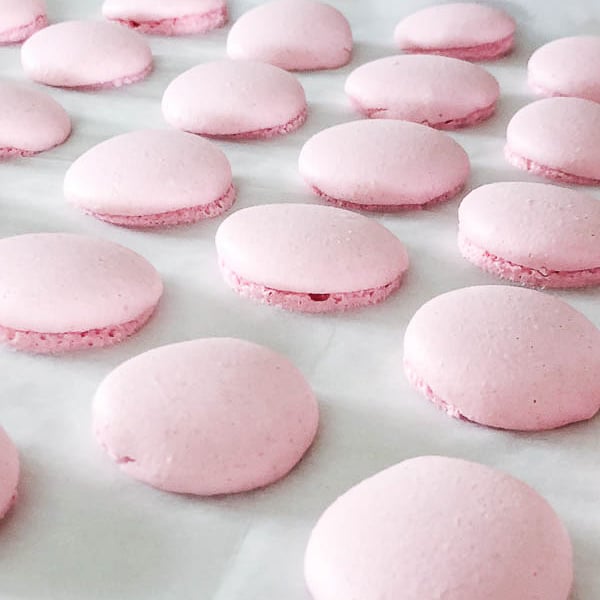
how to prevent lopsided macarons:
Main culprit for lopsided shells is poor air circulation. This could be due to uneven heat distribution and hot spots in the oven, convection settings with too strong fan. Here’re a few things you can do in this case:
- Flip the baking sheet upside down before piping macarons, so that there’s no edges around the sheet to block any heat circulation.
- Bake macarons one sheet at a time.
- Turn the baking sheet around half way through baking.
- If possible, bake on conventional setting, heat coming from top and bottom.
The next reason for lopsided macarons is improper piping technique. Pay close attention to following:
- Hold the piping bag with macaron batter straight at 90° and squeeze the batter from the top to one spot until the desired size reaches. Watch my macaron video for better illustration.
- Pipe the shells at least half an inch apart to give the shells enough room for air circulation.
And lastly, don’t dry your macarons for too long. Too thick skin may cause lopsided macarons.
Concaved (Inverted) shells or Stuck To Parchment
Possible causes:
- Low oven temp/ low heat from bottom
- Under-baked shells
- Not cooling the macarons before removing from parchment paper
How to prevent concaved, or stuck macarons:
- Make sure your oven is hot enough. Most of the time, ovens need good 30-45 minutes to preheat properly. Even if it beeps when it’s preheated, I highly recommend double checking with an oven thermometer.
- Be sure to check the macarons for doneness before taking them out. To test for doneness, gently touch the top of one macaron with your index finger and try wiggle it. If it wobbles side to side, they’re not ready. keep baking for another minute or so. The cooked shells should wiggle ever so slightly and firm to touch. When in doubt, cook a bit longer. In my opinion, it’s better to over-bake them than under-bake them.
- Make sure to cool the macarons on the baking sheet for at least 10 minutes before removing from parchment paper/silicone mat.

Whew, are you still with me? Thank you!!! I hope this macaron troubleshooting guide answers your questions and helps you to perfect your macaron skills.
And if there is anything I haven’t covered, please leave me a comment below. I’d like us, macaron-lovers, connect and discuss various problems we face baking macarons. Let’s get the discussion started.
More Favorites from Sweet & Savory
This post was originally published on December 21st, 2015, and last updated on February 16th, 2021.



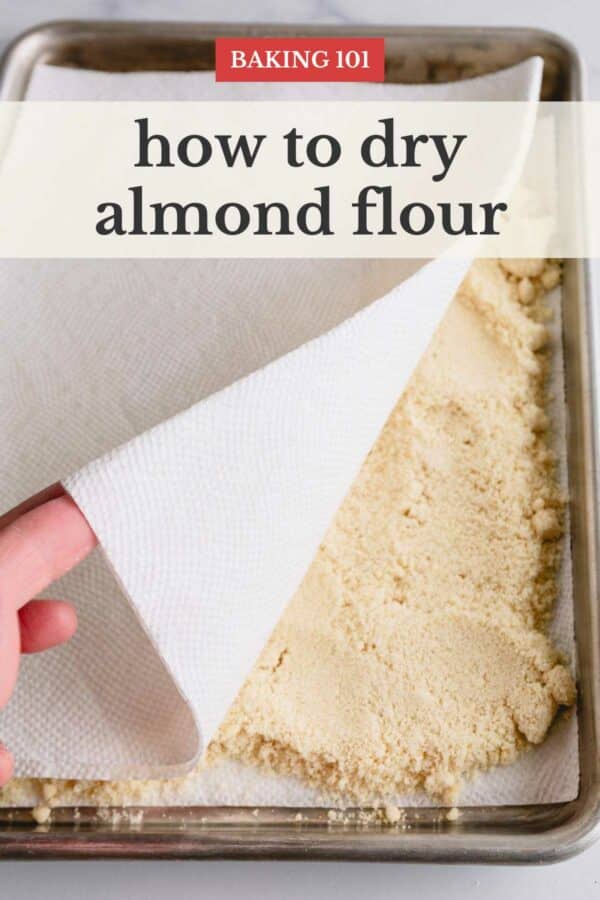


Hello! First, I wanted to thank you for your macaron series. I have watched all the videos and read all the posts – you have helped me tremendously! I’ve only been trying macarons for about a month, and so far with your help each batch gets better, and I’m able to identify why whatever problem I had happened. The one question I have is the timing for slow mixing your merangue. I have tried with my kitchenaid to keep it on 2 or 4, but after 20 minutes still barely have soft peaks. I was worried my mixer would overheat. bumping it up to 6 made better progress, and 8 really got me to stiff peaks. How long from foamy does it take you to stiff peaks at 4? Am I doing something wrong? I still feel my macarons could be fuller, and really want the slow setting to work. Thank you again for all of your help!!!!!
Hi, Nicole. It’s unlikely your mixer will overheat on speed 2 or 4. I’ve mixed meringue for up to 40 minutes on speed 2 with no issues. Every mixer is different, even the same brand model. (I have 2 KitchenAid 5qt mixers, and each takes different time to reach stiff peaks.) You just need to be patient, but if you want to expedite the process, you can always bump the speed up. For me, it usually takes about 25-35 minutes on speed 4 to reach stiff peaks. Just wondering, you start adding sugar when your meringue gets foamy, right? Because adding sugar also helps get more volume quicker.
Hola! Realmente muy interesante y enriquecedor tu post. Lo haces demasiado bien. Mi problema es que mi horno es a gas, o sea calienta solo abajo. A qué temperatura debo hornear y por cuánto tiempo? Muchas gracias 🙏
Do you have any suggestions f or high altitude adjustment? Some of my Macarons on the pan are cracking and are hallow. Should I add a bit more flour?
Hi, Kari. I don’t have much advice on high altitude baking. But I’ve had someone sharing that they had a good success with no adjustments at high altitude. Have you seen my post on fixing hollow macarons? If not, check it out. And as for cracking, you may need to play around with your oven settings.
Hi Shinee! I’ve been attempting macarons for over a week now and still haven’t gotten them right, but I’ve come close with your guides. Do you have any advice for someone who doesn’t have a stand mixer? I’ve been trying to use my electric hand mixer, and I’ve gotten my meringues to stiff peaks, but I don’t think they’ve been stiff enough. Does it take longer to achieve proper peaks with a hand mixer? Thank you for all your help!
Hi, Zach. Yes, it’ll take longer to reach stiff peaks with a hand mixer, because it’s not as powerful as a stand mixer. Just keep mixing a bit longer, and on a medium or medium high speed.
Hola!! Hice macarons y no logro que se sequen bien… ¿existe otra forma de hacerlo? Siempre se quedan pegados al papel
En cambio, hice el butter cream de chocolate y quedó perfecto!
Hi there! I’ve tried macarons a couple times. My first try last year was a disaster (no feet, lumpy, ugly lol) but then I studied and tried again recently and they looked a lot better! The only problem was, when I went to pull them off the tray after baking and cooling, the inside was very sticky and hollow and just stuck to the tray when I pulled the shells off. Would this be an oven temp problem or something else? They look fine from the outside, but theres just nothing inside
Hi! I’ve been having some issues with my macarons.. I used a recipe that I always use and they come out perfect. But, yesterday and today my macarons did not come out! They seem too bake perfectly, but once I pulled them out and touched the top they slightly sank in. I don’t know what I did wrong.. I’m using an Italian meringue method.
Hi, Katya!! I believe you reached out to me via IG. And thank you for sharing the images. It was helpful. I still believe it’s most likely due to the almond flour, as you had success previously and didn’t change anything.
Hi everyone. So my first batch was a DISASTER (cracked and sank). I was “prepared” for failure. Second batch worked out better (I decreased my oven heat to 150 degrees). However, my query is on the amount of sugar.
The recipe talks about 150grs (powdered and fine). Can I decrease that amount, I find that extremely sweet. Am scared to put the filling (extra sugar). The cookies are already very sweet. Any recommendation on the sugar side of things?
Hi, Laetitia. Unfortunately, I don’t recommend lowering the sugar amount, as it’s absolute minimum for the proper texture. If you check out other macaron recipes, you’ll noticed most macaron recipes have twice as much sugar. I specifically worked on this recipe to have the least amount of sugar without compromising the taste and texture. If you find the shells too sweet, I’m afraid macarons are not your kind of treat. And I mean that in kind way. 🙂
Loved reading this…thank you! What do you do to avoid the some shape on the bottom of the macaron?
Hi, Adrine. What do you mean by some shape on the bottom? Like the macarons are warped and not flat? I’m assuming you’re baking on parchment paper? Because warped macarons are mainly caused by parchment paper, as they tend to wrinkle. The parchment paper I use doesn’t really cause major issue for me, but if you can’t find parchment paper that doesn’t wrinkle as much, try teflon sheets instead.
I made macarons for the first time EVER, and thanks to you they turned out reasonably well. I definitely learned SO much from your tutorial, videos, and posts….I really appreciate all the info-THANK YOU! I do have one question…here in the UK (at least where I live), finding FINE ground almond flour is a challenge, so I’m going to order some. Do you have a favorite(s) brand you prefer?
Hi, Kendra! Thank you for your feedback! I’m so happy to hear that my posts and videos were helpful!! The following are my go-to almond flours in the order of preference:
1. Blue Diamond
2. Nature’s Eats
3. Bob’s Red Mill